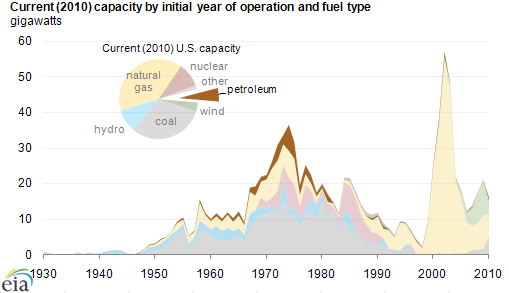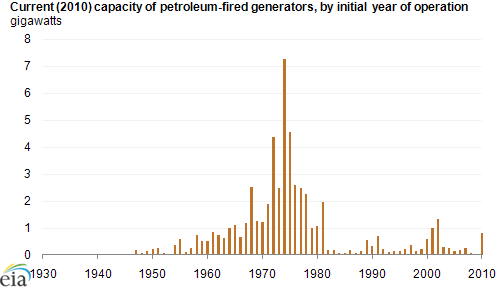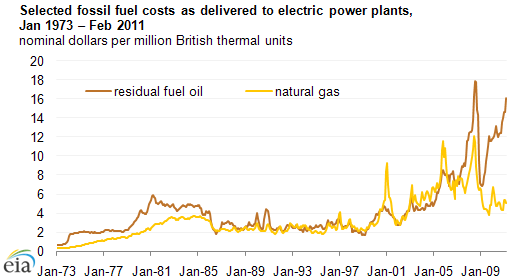
Minimal petroleum-fired electric capacity has been added in recent years

Note: Data for 2010 are preliminary. Generators with online dates earlier than 1930 are predominantly hydroelectric. Data include non-retired plants existing as of year-end 2010. This chart shows the most recent (summer) capacity data for each generator. However, this number may change over time, if a generator undergoes an uprate or derate.
Download CSV Data
The June 16 edition of Today in Energy examined the wide age range of electric power generators for all fuels; today's article looks specifically at petroleum-fired generators. Nearly 80% of petroleum-fired capacity still existing today was constructed prior to 1980.

Note: Data for 2010 are preliminary. Generators with online dates earlier than 1930 are predominantly hydroelectric. Data include non-retired plants existing as of year-end 2010. This chart shows the most recent (summer) capacity data for each generator. However, this number may change over time, if a generator undergoes an uprate or derate.
Download CSV Data
Generators reporting petroleum as their primary fuel made up 6% of total electric generating capacity at the end of 2010, but produced less than 1% of total generation that year. These data refer to bulk electric power generators connected to the grid; the majority of smaller portable and backup generators in end-use markets do burn oil.
Petroleum-fired generators either burn petroleum liquids (such as distillate or residual fuel oils) or petroleum coke, a refinery waste product that can be used as a fuel much like coal. The oil-fired (liquid-fired) generators are only used minimally today, due to a combination of high relative fuel prices, air pollution restrictions, and the low efficiencies of the older steam turbines and newer internal combustion units. Most oil-fired generators are used as peakers to supply power only at the times of highest electric power demand. In contrast, coke-fired generators tend to run at higher capacity factors and may burn a mix of petroleum coke and coal. In 2010, generation from petroleum coke made up 37% of all petroleum-fired generation.
Petroleum markets saw sharp increases in prices and supply shortages twice during the 1970s, first during the Arab Oil Embargo and then during the Iranian Revolution and Iran/Iraq war, which discouraged further petroleum-fired capacity additions.

Note: Residual fuel oil is one derivate of crude oil used extensively for electric power generation.
Download CSV Data